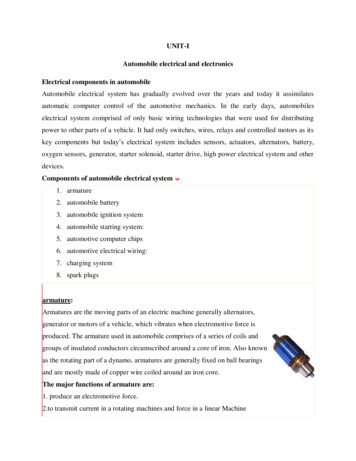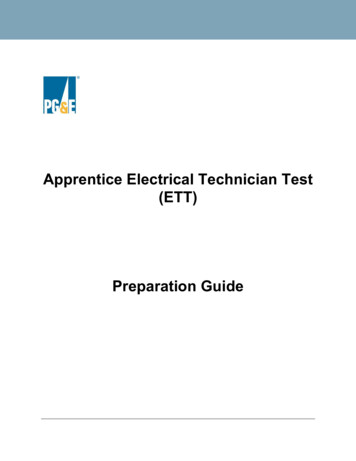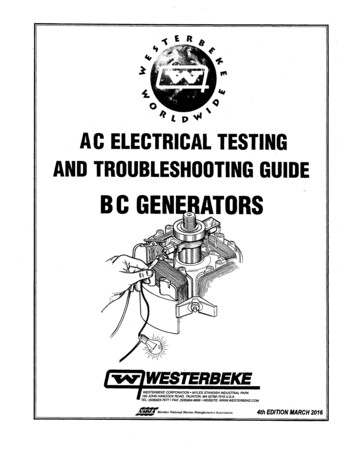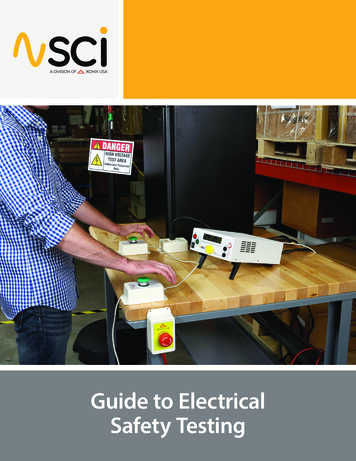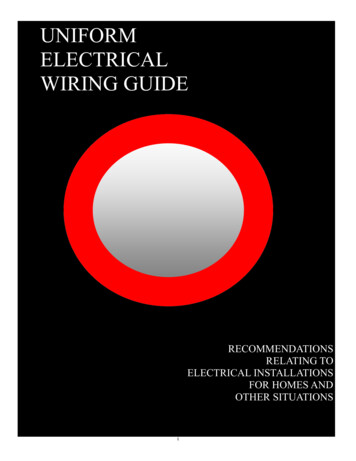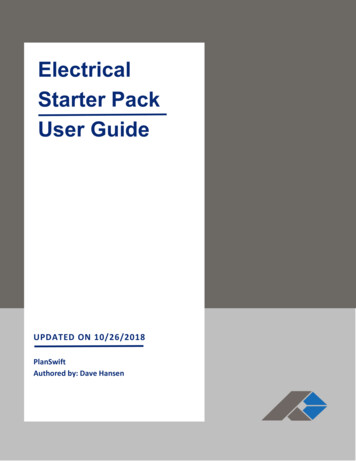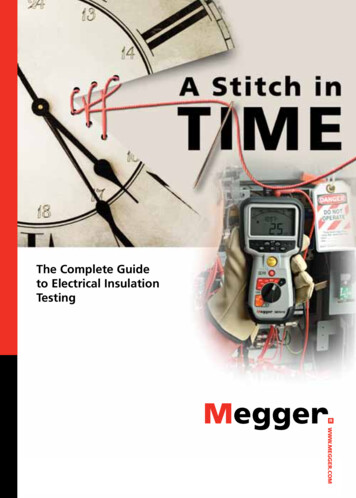
Transcription
The Complete Guideto Electrical InsulationTesting1WWW.MEGGER.COMA STITCH IN TIME
“A Stitch In Time”The Complete Guide toElectrical Insulation TestingCopyright 2006WWW.MEGGER.COMA STITCH IN TIME1
ContentsPageWHAT IS “Good” insulation?. 3What Makes Insulation Go Bad?. 4How Insulation Resistance is Measured. 5How to Interpret Resistance Readings. 6FACTORS AFFECTING INSULATION RESISTANCE READINGS. 8Types of Insulation Resistance Tests. 10test Voltage vs. Equipment Rating. 16AC Testing vs. DC. 17USE OF DC DIELECTRIC TEST SET. 18TESTS DURING DRYING OUT OF EQUIPMENT. 18EFFECT OF TEMPERATURE ON insulation Resistance. 21Effects of humidity. 23Preparation of Apparatus to test. 24Safety Precautions. 26Connections for testing insulation resistance ofelectrical equipment. 27Additional Notes About using A Megger Insulation Tester. 33Interpretation-Minimum Values. 36Minimum Values for Insulation Resistance. 38Tests Using Multi-Voltage Megger Insulation Testers. 42Step-Voltage Method. 48Use of a Guard Terminal. 50Bushings, Potheads and Insulators. 54Outdoor Oil Circuit Breakers. 57Setting up a Maintenance program. 60How Often Should You Test?. 60MEGGER 5 AND 10 KV INSULATION TESTERS. 62MEGGER 1 KV INSULATION TESTERS. 642A STITCH IN TIME
WHAT IS “Good” insulation?Every electric wire in your plant – whether it’s in a motor, generator, cable,switch, transformer, etc. – is carefully covered with some form of electricalinsulation. The wire itself is usually copper or aluminum, which is known tobe a good conductor of the electric current that powers your equipment. Theinsulation must be just the opposite from a conductor: it should resist currentand keep the current in its path along the conductor.To understand insulation testing you really don’t need to go into themathematics of electricity, but one simple equation – Ohm’s law – can be veryhelpful in appreciating many aspects. Even if you’ve been exposed to this lawbefore, it may be a good idea to review it in the light of insulation testing.The purpose of insulation around a conductor is much like that of a pipecarrying water, and Ohm’s law of electricity can be more easily understood bya comparison with water flow. In Fig. 1 we show this comparison. Pressure onwater from a pump causes flow along the pipe (Fig. 1a). If the pipe were tospring a leak, you’d waste water and lose some water pressure.With electricity, voltage is like the pump pressure, causing electricity to flowalong the copper wire (Fig. 1b). As in a water pipe, there is some resistanceto flow, but it is much less along the wire than it is through the insulation.Figure 1–Comparison of water flow (a) with electric current (b).A STITCH IN TIME3
Common sense tells us that the more voltage we have, the more currentthere’ll be. Also, the lower the resistance of the wire, the more current forthe same voltage.Actually, this is Ohm’s law, which is expressed this way in equation form:E IxRwhere, E voltage in voltsI current in amperesR resistance in ohmsNote, however, that no insulation is perfect (that is, has infinite resistance) sosome electricity does flow along the insulation or through it to ground. Sucha current may only be a millionth of an ampere (one microampere) but it isthe basis of insulation testing equipment. Note also that a higher voltagetends to cause more current through the insulation. This small amount ofcurrent would not, of course, harm good insulation but would be a problemif the insulation has deteriorated.Now, to sum up our answer to the question “what is ‘good’ insulation?”We have seen that, essentially, “good” means a relatively high resistanceto current. Used to describe an insulation material, “good” would alsomean “the ability to keep a high resistance.” So, a suitable way ofmeasuring resistance can tell you how “good” the insulation is. Also, if youtake measurements at regular periods, you can check trends toward itsdeterioration (more on this later).What Makes Insulation Go Bad?When your plant electrical system and equipment are new, the electricalinsulation should be in top notch shape. Furthermore, manufacturers of wire,cable, motors, and so on have continually improved their insulations forservices in industry. Nevertheless, even today, insulation is subject to manyeffects which can cause it to fail – mechanical damage, vibration, excessiveheat or cold, dirt, oil, corrosive vapors, moisture from processes, or just thehumidity on a muggy day.In various degrees, these enemies of insulation are at work as time goeson – combined with the electrical stresses that exist. As pin holes or cracksdevelop, moisture and foreign matter penetrate the surfaces of theinsulation, providing a low resistance path for leakage current.4A STITCH IN TIME
Once started, the different enemies tend to aid each other, permittingexcessive current through the insulation.Sometimes the drop in insulation resistance is sudden, as when equipmentis flooded. Usually, however, it drops gradually, giving plenty of warning,if checked periodically. Such checks permit planned reconditioning beforeservice failure. If there are no checks, a motor with poor insulation, forexample, may not only be dangerous to touch when voltage is applied,but also be subject to burn out. What was good insulation has become apartial conductor.How Insulation Resistance is MeasuredYou have seen that good insulation has high resistance; poor insulation,relatively low resistance. The actual resistance values can be higher or lower,depending upon such factors as the temperature or moisture content of theinsulation (resistance decreases in temperature or moisture). With a littlerecord-keeping and common sense, however, you can get a good picture ofthe insulation condition from values that are only relative.The Megger insulation tester is a small, portable instrument that gives youa direct reading of insulation resistance in ohms or megohms. For goodinsulation, the resistance usually reads in the megohm range.The Megger insulation tester is essentially a high-range resistance meter(ohmmeter) with a built-in direct-current generator. This meter is of specialconstruction with both current and voltage coils, enabling true ohms to beread directly, independent of the actual voltage applied. This method is nondestructive; that is, it does not cause deterioration of the insulation.Figure 2–Typical Megger test instrument hook-up to measure insulation resistance.A STITCH IN TIME5
The generator can be hand-cranked or line-operated to develop a highDC voltage which causes a small current through and over surfaces of theinsulation being tested (Fig. 2). This current (usually at an applied voltageof 500 volts or more) is measured by the ohmmeter, which has an indicatingscale. Fig. 3 shows a typical scale, which reads increasing resistance valuesfrom left up to infinity, or a resistance too high to be measured.Figure 3–Typical scale on the Megger insulation tester.How to Interpret Resistance ReadingsAs previously mentioned, insulation resistance readings should be consideredrelative. They can be quite different for one motor or machine tested threedays in a row, yet not mean bad insulation. What really matters is the trendin readings over a time period, showing lessening resistance and warningof coming problems. Periodic testing is, therefore, your best approach topreventive maintenance of electrical equipment, using record cards as shownin Fig. 4.Figure 4–Typical record of insulation resistance of a mill motor. Curve A shows test values asmeasured; Curve B shows same values corrected to 20 C (see page 22), giving a definite downwardtrend toward an unsafe condition. Reverse side of card (at right) is used to record the test data.6A STITCH IN TIME
Whether you test monthly, twice a year, or once a year depends upon thetype, location, and importance of the equipment. For example, a smallpump motor or a short control cable may be vital to a process in your plant.Experience is the best teacher in setting up the scheduled periods for yourequipment.You should make these periodic tests in the same way each time. That is,with the same test connections and with the same test voltage applied forthe same length of time. Also you should make tests at about the sametemperature, or correct them to the same temperature. A record of therelative humidity near the equipment at the time of the test is also helpfulin evaluating the reading and trend. Later sections cover temperaturecorrection and humidity effects.In summary, here are some general observations about how you can interpretperiodic insulation resistance tests, and what you should do with the result:ConditionWhat To Do(a) Fair to high values No cause for concern.and well maintained.(b) Fair to high values, Locate and remedy the cause andbut showing acheck the downward trend.constant tendencytowards lower values.(c) Low but well maintained.Condition is probably all right, butcause of low values should bechecked.(d) So low as to be unsafe.Clean, dry out, or otherwise raise thevalues before placing equipment inservice. (Test wet equipment whiledrying out.)(e) Fair or high values,previously wellmaintained but showingsudden lowering.Make tests at frequent intervals untilthe cause of low values is locatedand remedied; or until the valueshave become steady at a lowerlevel but safe for operation; or untilvalues become so low that it is unsafeto keep the equipment in operation.A STITCH IN TIME7
FACTORS AFFECTING INSULATION RESISTANCE READINGSRemember that the measured resistance (of the insulation) will bedetermined by the voltage applied and the resultant current (R E/I).There are a number of things that affect current, including temperatureof the insulation and humidity, as mentioned in the previous section.Right now, let’s just consider the nature of current through insulationand the effect of how long voltage is applied.Current through and along insulation is made up partly of a relativelysteady current in leakage paths over the insulation surface. Electricityalso flows through the volume of the insulation. Actually, as shown inFig. 5, our total current comprises three components:1. Capacitance Charging CurrentCurrent that starts out high and drops after the insulation has beencharged to full voltage (much like water flow in a garden hose whenyou first turn on the spigot).2. Absorption CurrentAlso an initially high current which then drops (for reasons discussedunder the section Time-Resistance Method).3. Conduction or Leakage CurrentA small essentially steady current both through and over theinsulation.As shown in Fig. 5, the total current is the sum of the three componentsand it is this current that can be measured directly by a microammeter,or in terms of megohms at a particular voltage by means of a Meggerinstrument (ohmmeter). Because the total current depends upon thetime that the voltage is applied, you can see now why Ohm’s Law R E/Ionly holds, theoretically, at an infinite time (that is, you’d have to waitforever before taking a reading).In practice, as you will see in the test methods described below, youread a value that is the apparent resistance – a useful value to diagnosetroubles, which is what you want to do.8A STITCH IN TIME
Figure 5–Curves showing components of current measured during DC testing of insulation.Note also in Fig. 5 that the charging current disappears relatively rapidlyas the equipment under test becomes charged. Larger units with morecapacitance will take longer to be charged. This current also is the storedenergy initially discharged after your test, by short-circuiting and groundingthe insulation. ALWAYS TAKE THIS SAFETY MEASURE.You can see further from Fig. 5 that the absorption current decreases at arelatively slow rate, depending upon the exact nature of the insulation. Thisstored energy, too, must be released at the end of a test, and requires alonger time than the capacitance charging current – about four times as longas the voltage was applied.With good insulation, the conduction or leakage current should build up to asteady value that is constant for the applied voltage, as shown in Fig. 5. Anyincrease of leakage current with time is a warning of trouble, as discussed inthe tests described in the following section.A STITCH IN TIME9
With a background now of how time affects the meaning of instrume
from left up to infinity, or a resistance too high to be measured. Figure 4–Typical record of insulation resistance of a mill motor. Curve A shows test values as measured; Curve B shows same values corrected to 20 C (see page 22), giving a definite downward trend toward an unsafe condition. Reverse side of card (at right) is used to record the test data. Figure 3–Typical scale on the .

